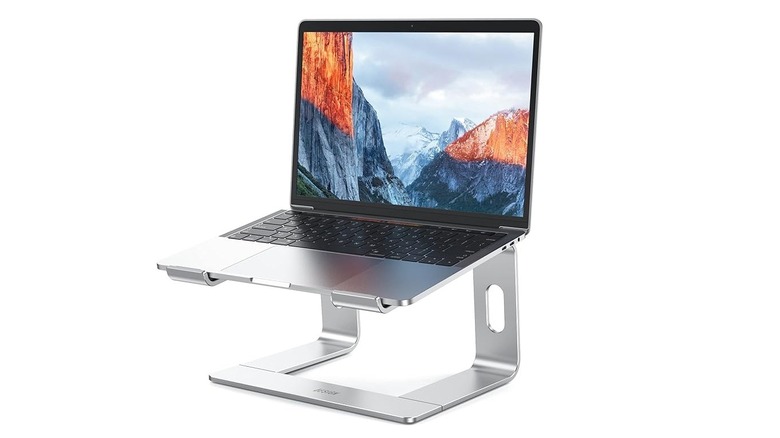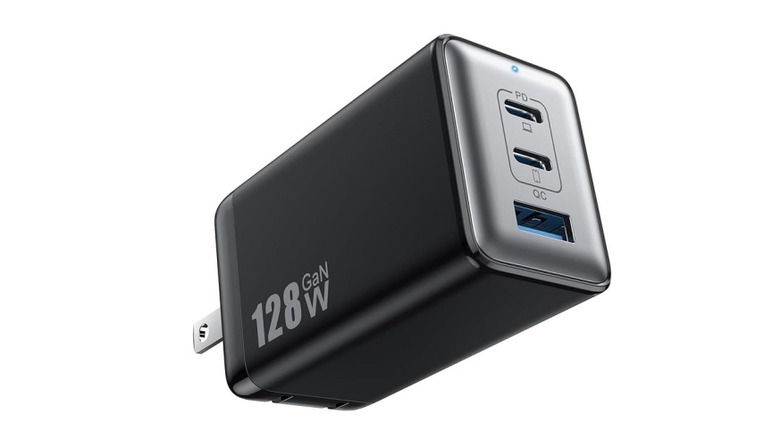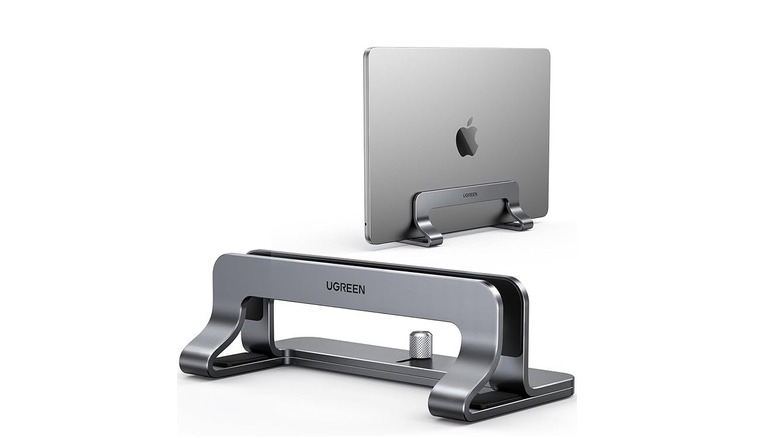5 Cheap Accessories Every MacBook Owner Should Have In 2025
We may receive a commission on purchases made from links.
If you want a great laptop, get a MacBook. The average lifespan of a MacBook is arguably much longer than just about any comparable Windows device, long enough that you can safely buy one used. Macs are efficient, easy to use, have great battery life, and are deceptively powerful for workhorse tasks like image processing and video exports. Then you see the price. After spending $200 on RAM upgrades, and then another bombshell on AppleCare, you may not exactly be in the best mood for adding pricey accessories to an already beleaguered credit card bill. So don't. Some of the best accessories a Mac owner can get are available for cheap.
For these accessories, we're going to assume you're someone whose MacBook sees equal amounts of time on the desk at home and away from it on travels. Our recommendations apply to both the MacBook Pro and the MacBook Air series. All of these are based on personal experience; as a fairly recent MacBook owner, these are all items that have become a must. Read on for the top accessory recommendations for any MacBook user — new or old.
Laptop skin
Apple's MacBooks are distinctive for their minimalistic aluminum shells. But if there's anything aluminum is known for, it's being soft and easily marred, even when anodized. The recent scratchgate controversy is just one in a long, long train of examples. MacBook aluminum is prone to scuffs, scratches, and stains of all kinds, which appear more visible due to the light, plain metal nature of the design — or on darker, anodized options. To be clear, these are superficial concerns, but they matter on a costly MacBook, especially one you plan to resell later on. Consider getting a laptop skin to protect the aluminum from all the abuse it may endure on planes and coffee tables.
We recommend the SkinIt brand, which creates custom and pre-made skins for most MacBook models. Bear in mind that this particular option covers the iconic Apple logo on the back of the screen, but this might not be an issue since no MacBook released after 2015 has had a glowing icon. The skins start at $29.99. If you want something more personalized, Etsy also offers a raft of custom-made options at all price points.
Make sure you buy the correct size for your specific model. The MacBook Air comes in 13" and 15" screen sizes, while the Pro comes in 14" and 16" sizes. MacBooks since the M2 chip have had the same size dimensions, but a MacBook M1 Air (or older) would require a different skin. Using a skin may impact the thermal performance of your MacBook — particularly the fanless MacBook Air, which has a history of poorly dissipating heat. Consider getting a skin that only covers the back of the screen to alleviate this.
Laptop sleeve
Speaking of damaged aluminum, it's time to get yourself a proper case if you plan on taking your MacBook anywhere outside the home. Apple's MacBook Laptop Portfolio costs an eye-watering $80.95 for a waterproof sleeve. That includes, by the way, no zippers and no extra pockets. Don't buy it just because Apple makes it convenient to bundle everything you need at checkout. A good laptop sleeve or case can be had for very, very cheap.
Anything that serves as a barrier between your MacBook's delicate aluminum and the cruel outside world will do the job nicely. We recommend this Mosiso Laptop Sleeve. It can support MacBooks from the 13-inch MacBook Air to the 16-inch MacBook Pro. We like the extra pocket on the top to store a mouse, and the fleece lining to keep your aluminum shell pristine.
Of course, a sleeve like this is going to do next to nothing to protect your MacBook from a drop. Consider something like the tomtoc 360 Protective Laptop Sleeve, which includes extra padding in the event of a fall. You might even want a hard case if you're dedicated to protecting your MacBook. For sleeves that don't have much room in their pockets, get one of these affordable alternatives to Apple's Magic Mouse to bring with you on the road. This is an area where you're perfectly fine going as cheap as possible. The intent is to prevent unnecessary travel wear on your MacBook's aluminum shell, not to port your baby around in premium leather. Plus, a case that isn't as premium may make it less of a target for theft.
Wall charger
iPhones have stopped shipping with wall chargers since the iPhone 12. Fortunately, the MacBook hasn't followed that trend ... yet. We're crossing our fingers that the decision to remove the charging plug from the box in Europe doesn't find its way across the pond. Anyway, your MacBook does come with its own excellent MagSafe charger, but you may wish to purchase your own. You can charge your MacBook with USB-C instead of MagSafe, in case you weren't aware. A third-party charging brick costs less while supplying multiple devices and reducing the number of gadgets you carry around while traveling.
For that, we recommend something like this 128W GaN III charger from Pxwaxpy for $35.95. It claims to be able to charge your MacBook and an additional two smartphones at the same time. The inclusion of a USB-A port is a nice touch if you still have a USB-A-to-C charging cable. You will need to have the right USB-C cable to take advantage of the fastest charging speeds, but we'd wager purchasing the brick and the cable would cost you less than buying Apple's $59.00 single-USB-C power adapter.
The only downside here is that to get wall chargers that are cheap — assuming your definition of cheap is around $40 or less — you will have to settle for ephemeral letter-jumble brands like Pxwaxpy. Buying from the more reputable Anker or Baseus will cost you more. However, this particular model has a 4.3-star average across over 2,000 reviews. Just like buying a cheap charger for your iPhone, it probably won't damage your MacBook, but the lack of safety features could present a fire risk. If you are going to splurge on any of the items on this list, this is the one to do it for.
Vertical stand
Laptops are so powerful these days that you can comfortably use them with the lid closed, desktop tower-like, while plugged into a larger external display. This is known as clamshell mode. The problem is finding a place for your MacBook on a crowded desk. The easiest way to save space and make sure your MacBook is properly venting its heat is with a vertical stand. We'd recommend something like this Ugreen Vertical Laptop Stand Holder designed for MacBooks of any size. The screw adjuster makes it easy to set the stand to your MacBook's thickness, and the protective pads keep it from scratching upon insertion. Plus, it matches the aluminum aesthetic of a MacBook quite well.
The option we've recommended retails for $25.99, but we recommend it with the assumption that you're a more frequent desktop user who's concerned about appearances and decor. Laptop vertical stands can go for much cheaper if you're not picky. I personally use a wooden stand I picked up for a couple of dollars, which serves me plenty well.
Vertical stands are excellent for space savings, but not if you want to use your MacBook's Touch ID or the webcam. Trust me, it's a huge pain to safely unplug everything and pull your MacBook out to access those things. Instead, you might consider something like this Besign LS03 Aluminum Laptop Stand, which raises your MacBook up on a 45-degree holder and gives you back that desk space beneath it. Stands of this variety can make it difficult to use a dual-monitor setup on a small desk, so carefully measure and evaluate your setup before you buy.
Docking station
One thing you should know before buying a MacBook is that you're going to have to get used to some disappointingly limited I/O, especially if you go with a MacBook Air instead of the Pro. That might not be a huge issue when you're on the go, but it does cause a headache or two when you want to plug in hard drives, dongles for USB peripherals, charging cables, and more without having to subject your ports to a Hunger Games death match for a spot. This tip is particularly for those who use their MacBook a lot at the desk.
The distinction between USB hub and USB dock can be a bit confusing, but generally speaking, USB hubs are the cheaper, portable dongles that you can use at a desktop or take with you on the go. Our recommendation is the 13-in-1 USB-C docking station from Lionwei. You've got dual HDMI support, multiple USB-A and USB-C plug-ins, Ethernet, and even DisplayPort if your monitor supports it. This model retails for $79.99 and is currently on sale for $49.99 at the time of writing. USB-C hubs can be had for much cheaper, but you naturally sacrifice options and speed. You're going to have to balance between functionality and price here, just as you did with the wall charger.
Unfortunately, to get the good stuff you really have to invest. Proper docking stations easily start out in the $100 range, and I've seen the most recommended options clear $200. Take this Baseus Docking Station, which starts at $129.99. If you plan to use multiple monitors, high-speed USB storage media, and charge your phone at your desk, we recommend it or something like it.





